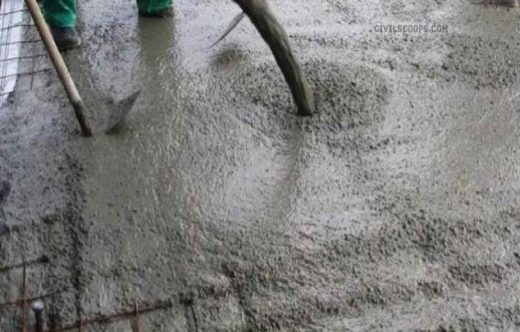What is Concrete Retarder?
Retarders are additives that slow the setting of cement paste and, by extension, mixtures like mortar or concrete that contains cement. Concrete retarders are also known as retarding admixtures or just retarders. Adding a retarder to the concrete mix can delay the setting time by up to an hour. They slow the hardening process in warmer weather to give workers more time to mix, transport and place the concrete. Retarders not only slow down the process, but they also save water.

Fig 1: Concrete Retarder
Courtesy: concretechemicals.home.blog
Mechanism of Retardation:
The hydration reactions are momentarily halted by dissolving a retarder in the mixing water or spraying it on the concrete’s surface, resulting in a longer resting period. The mechanisms that develop themselves are influenced by the specifics of the retarder and cement used. It’s also important to know that the things that cause retardation are only there for a short time. After a set amount of time, the mechanisms stop working, but the watering continues. The following are the four mechanisms of retardation:
i) Adsorption:
A retarding additive is deposited onto the cement particles’ surfaces. The retarding admixture forms a Protective skin around the cement particles. Because of this diffusion barrier, water molecules have a harder time reaching the surface of the unhydrated cement particles, slows down the hydration process. As a result, the cement paste retains its plasticity for longer because there are not enough hydration products to make it hard. This retardant additive reacts with the cement’s C3A, comes out of the solution, and is mixed into the hydrating substance.
ii) Nucleation:
In response to the presence of water, the cement particles’ surfaces expel calcium ions and hydroxyl ions. The hydration products C2S and CS crystallize once the concentration of those ions reaches a threshold value. As the cement cures, the nuclei of calcium hydroxide adsorb a retarding admixture, which inhibits further nucleation until the cement reaches super saturation.
iii) Complexation:
During the first few minutes, calcium ions released by the cement grains form some complex with other ions. When these complexes form, they make the cement easier to dissolve. In the aqueous phase of the cement paste, the concentration of Ca 2+, OH-, Si, Al, and Fe will go up during the hydration process if a retarding admixture is present. The buildup of calcium and hydroxyl ions in the solution stops the calcium and hydroxyl ions from clumping together to form calcium hydroxide, slowing the hydration process.
iv) Precipitation:
In precipitation, the retarder reacts with the extremely alkaline solution to generate insoluble derivatives. This process is quite similar to adsorption. When water and cement come into contact, the pH of the solution quickly climbs to over 12 within the first few minutes. Protection layers of these insoluble compounds precipitating around cement particles inhibit hydration. The coating prevents water molecules from making excellent contact with the cement particles by acting as a diffusion barrier.
Types of Concrete Retarders:
1. Organic Retarder:
i) Phosphonates
ii) Lignosulphonates
iii) Sugars
iv) Hydroxycarboxylic acids and their salts
2. Inorganic Retarder:
i) Salts of Pb, Zn, Cu, As, Sb
ii) Borates
iii) Phosphonates
How Retarding Additives affect Concrete’s Properties:

Fig 2: How Retarding Additives affect Concrete’s Properties
Courtesy: civilscoops.com
1. Strength:
When applied to concrete, retarding admixtures reduce the initial compressive strength relative to untreated concrete.
2. Slump Loss:
The use of retarding admixtures has been shown to greatly improve the initial workability of concrete by decreasing slump loss.
3. Durability:
It is expected that retarded concrete when properly cured, will have the same durability as ordinary concrete of the same volume.
4. Workability and Rheological Values:
The workability of concrete is also marginally affected by retarding admixtures. They can lead to a 60-100mm more initial slump.
5. Volume Deformation:
The addition of retarding admixtures does not significantly alter creep or drying shrinkage, although it may increase plastic shrinkage.
6. Air Entrainment:
Most retarding admixtures do not bring in air, but some do. Especially those based on Hydroxycarboxylic acid, which can reduce air content.
7. Bleeding:
The use of retarding admixtures always increases the risk of bleeding in concretes.
8. Freeze-Thaw Cycles:
Air-entraining admixtures are frequently used to increase the concrete’s resistance to freezing and thawing. The air cells act as tiny expansion chambers for the freezing water after being frozen in the concrete.
9. Heat of Hydration:
While retarding admixtures does not diminish concrete’s heat production, they do delay the peak temperature rise by an amount of time equal to that by which the concrete was retarded.
Uses of Concrete Retarder;
- Most of the times, retarding admixtures are added to concrete when it is hot outside.
- Spraying a retarder on the surface of the formwork stops the matrix from hardening where it meets the formwork. On the other hand, the rest of the concrete gets hard.
- When building something big or very big, people use retarders.
- Admixtures that reduce the reaction rate are utilized during the grouting process for oil wells.
Advantages of Concrete Retarder:
- Concrete’s workability and cohesion are preserved by retarding admixtures, which also lengthen the time it takes to set.
- The use of concrete retarders can mitigate the dangers of long-distance delivery in hot weather by offsetting the hastening effect of high temperature on the initial setting time.
- Concrete retarder is used to delay the hardening of concrete between pours and prevent the formation of cold joints in major building projects.
- When poor sand grading is unavoidable, concrete retarders can be used to lessen the amount of segregation and bleeding that occurs.
- By delaying the setting time and increasing the workability of concrete, retarding admixtures enhances permeability.
Disadvantages of Concrete Retarder:
- Using water reducers with concrete retarders is possible, but curing must be monitored closely to prevent bleeding and fissures.
- Gypsum can delay concrete setting, but only if the process is well monitored and managed; otherwise, too much gypsum could lead to undesirable expansion and an endless delay in a concrete setting.
- Depending on the cement’s water-cement ratio, cement content, and C3A concentration, the appropriate dosage of retarding admixtures must be determined.
- Concrete retarders may have varying effects on various cement varieties in differing concentrations.
Conclusion:
Concrete retarders are a mixture that slows down the chemical process of hydration so that the concrete stays soft and is easy to work with for a long time. Retarders are used in hot climates to counteract high temperatures and speed up the process of establishing concrete’s properties.
It’s useful for keeping the consistency of concrete workable in hot weather, through challenging putting conditions, during lengthy transportation, etc. However, it is strongly suggested that trial mixes with the real cement used in the construction should be evaluated before applying a retarder. A mistake during construction might lead to wasted time and money.
References:
1. Ballieu, Pieter. “(PDF) Concrete Setting Retarder Mechanism | Pieter Ballieu – Academia.edu.” (PDF) Concrete Setting Retarder Mechanism | Pieter Ballieu – Academia.edu, www.academia.edu/9689617/Concrete_setting_retarder_mechanism. Accessed 11 Oct. 2022.
2. Pvt. Ltd., NBM Media. “Effect of Usage of Admixture in Concrete.” Effect of Usage of Admixture in Concrete, 1 Dec. 2008, www.nbmcw.com/product-technology/construction-chemicals-waterproofing/concrete-admixtures/effect-of-usage-of-admixture-in-concrete.html.
3. “All House Related Solutions – GharPedia.” All House Related Solutions – GharPedia,
gharpedia.com/blog/concrete-retarders-pros
cons/#:~:text=With%20the%20use%20of%20concrete,and%20improved%20workability%20of%20concrete. Accessed 11 Oct. 2022.
4. “What Is Retarder in Concrete?” Real Estate Forum by NoBroker.com, 25 Aug. 2022, www.nobroker.in/forum/what-is-retarder-in-concrete.
5. Team, Dream Civil. “Concrete Retarder | Types, Effects, Uses and Cost of Concrete Retarder.” Dream Civil, 2 Dec. 2021, dreamcivil.com/concrete-retarder.
6. https://www.concreteconstruction.net/how-to/materials/retarders-for-concrete_o. www.concreteconstruction.net/how-to/materials/retarders-for-concrete_o. Accessed 11 Oct. 2022.
If you have a query, you can ask a question here.


